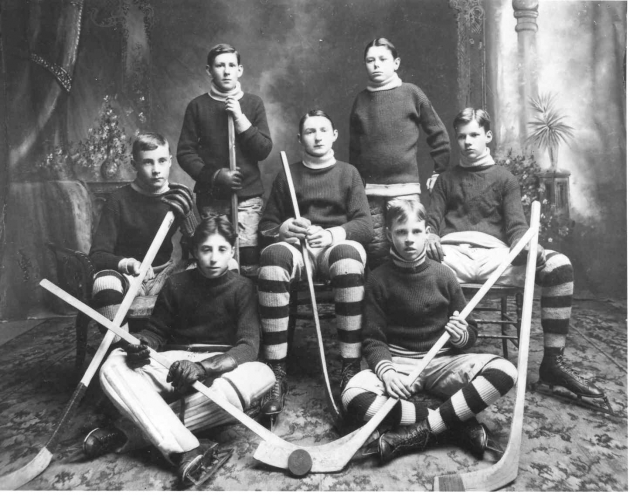Sports
Playground Leagues and the Origins of Urban Jewish Athletics
By the early 1900s, the sporting heritage of large Ontario cities like Toronto had been well established, with all major sports of the period being represented through either professional or amateur leagues. Baseball, basketball, rowing, cricket, lacrosse, hockey, skating, curling, yachting, swimming, track and field, rugby and football clubs were offered through public schools, colleges and the local Y.M.C.A. However, due to geographic and financial limitations, many adult Jewish immigrants did not participate in these established leagues.
Between 1900 and 1940, most of Toronto’s Jewish immigrants lived first in "The Ward" and then within Kensington Market and the surrounding area. In the city’s downtown core, public space for amateur sports was confined to playgrounds, school yards and inner-city parks. It was there that Jewish youth first took advantage of sporting and leisure activities. Playground leagues, like Toronto’s Elizabeth Street Playground, gave Jewish youth an opportunity for physical activity and interaction with other ethnic groups. And while sporting rivalries were inevitable, the infamous Christie Pits riot is an example of the antisemitism that permeated the social interactions between Jewish and non-Jewish residents of Toronto during this period, even in the sporting arena.
The Young Men’s Hebrew Association (Y.M.H.A.)
Beyond the playground leagues, organized sports for Jewish youth were usually offshoots of various Jewish cultural clubs, such as the Judean Literary and Debating Society and the Young Men’s Hebrew Progressive Club. The first documented sports organizations in Toronto were the Young Mens’ Hebrew Athletic Club Ltd., which received its letters-patent in 1901; the Judean Athletic Club, established in 1908; followed by the Hebrew Literary and Athletic Club in 1914. All offered a variety of popular and affordable sports, such as baseball, basketball, hockey and rugby.
By the 1910s, Y.M.H.A.s, modeled after the Y.M.C.A., had already been established throughout North America. However, in 1912 the Jewish Times reported that no such facility existed in Toronto, despite growing demand. Instead, most young Jewish men were members of the Y.M.C.A. In 1918, the Y.M.C.A. adopted a policy of segregating its athletic groups, which encouraged Jewish athletes to seek their own sports facilities. The Toronto Y.M- Y.W.H.A. of the early- to mid-1920s brought over seventy disparate social and recreational groups together. However infighting, coupled with financial hurdles, kept the city from establishing a dedicated Y.M.H.A. facility.
Initially the Y.M.H.A. operated out of the Brunswick Avenue Talmud Torah during after-hour periods and other rented rooms and locations around the city. Several championship teams and notable athletes emerged from the “Y”, in sports such as basketball, swimming, boxing, weightlifting and wrestling. The Brunswick Avenue “Y” was built in 1937, and included facilities for a range of sports. The space was upgraded in the 1940s to accommodate even more activities, such as the highly popular handball. In 1953, construction of the Bloor Street building was completed and programming increased even further, accommodating large scale demonstrations and tournaments in sports like judo and squash, as well as smaller wellness programming like First Aid training.
Today's Y.M.H.A.'s of Toronto are the downtown Miles Nadal JCC, the uptown Prosserman JCC and the Schwartz/Reisman JCC in Vaughan. They are inclusive athletic facilities that continue to offer the Jewish residents of Toronto a venue for sport, leisure and culture.
The Maccabiah Games
The Maccabi World Union is an international Jewish sports organization formed in 1921 with the aim of fostering physical education, and the belief in Jewish heritage and the Jewish nation. It currently spans 5 continents and more than 50 countries, including Canada. Representing some 400,000 members, the Maccabi World Union organizes the Maccabiah Games, a prominent international Jewish athletics event. Between 1918 and 1939, Maccabi’s athletes routinely represented their nations in international events like the Olympic Games. European Maccabi Games were held regularly, and the movement gained popularity on other continents, including North America. Today the organization comprises six confederations: Maccabi Israel, European Maccabi confederation, confederation Maccabi North America, confederation Maccabi Latin America, Maccabi South Africa and Maccabi Australia. Since 1953, the Maccabiah Games have been proudly staged every four years, and in 1960 the Maccabi World Union was recognized by the International Olympic Committee as “an international sports federation of Olympic standing.”
